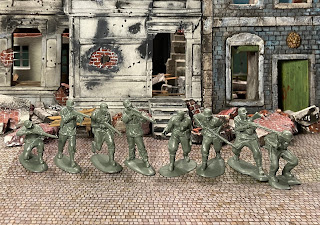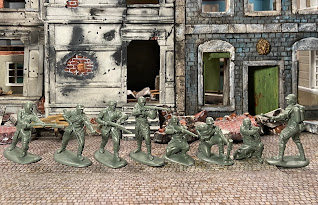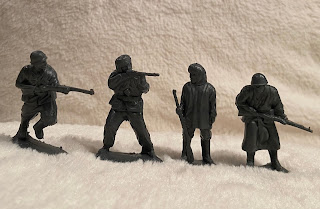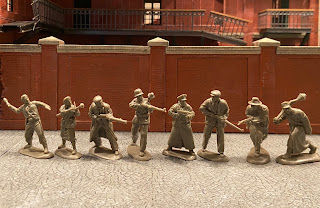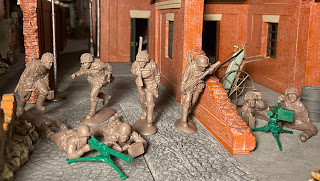Latest Update: Italian Paratroops at the bottom of this post
__________________
Mars is a manufacturer based out of Ukraine, which has been on the 1/72 scene for a while, at least back to 2007 which is when their website is copyrighted. They entered the 1/32 market a few years ago, in 2016 or so, with some non-WWII sets, with an emphasis on Vietnam and some Afghanistan sets. It has been during the recent years 2018-2022, that they have made a strong push into 1/32 WWII. Mostly by upscaling their 1/72 sets, which is in part why they have been able to issue so many sets in quick succession. The best part about Mars throwing its hat into ring, is that they are coming up with sets that had not received much attention in the past. Besides the sets that are listed on this post, they already announced several more that should be quite exciting, but I won't ruin the surprise for you :-) Take a look and judge for yourself!
Mars German Elite Division (Waffen SS)
As far as this 'Elite Infantry' set, I have to say that it is just OK. For some reason the way the clothes look on the legs of these figures seems a bit artificial. Either too baggy, or the men's legs are too skinny to fill them... not sure what's going on. I also found it amusing that they preferred to avoid calling the set Waffen SS and went with 'Elite Division'. Anyhow, the poses are dynamic enough for my taste, and they could easily be used as regular infantry if you also wanted to avoid depicting Waffen SS troops.
Mars German Luftwaffe Field Division
This is one of those sets that had not been represented before, as far as I know. Not much to tell them apart from regular infantry or, even trickier, from Waffen SS. When I have seen them in pictures, they are usually wearing cammo smock or the tent quarters, which is what several of these guys are wearing. From what I read, these units suffered terrible casualty rates, given the fact that they had very limited training in ground combat tactics, as they had been hastily repurposed from air force duties to frontline infantry. Maybe that's why they felt compelled to include a figure getting hit.
Mars German Naval Infantry
Another set that I have not seen manufactured before. Not sure if these guys are meant to represent the Marinestosstruppkompanie, the landing parties that a Naval Force would usually carry with them, or whether they were surplus sailors which had been repurposed as ground infantry, as was the case with the Luftwaffe Field Division. In any case, it is an interesting and unique set. In terms of the sculpting, this set is pretty decent, although the poses could be a bit more dynamic.
Mars German Panzergrenadiers
If not because of the name, it is hard to tell that these guys were mechanized infantry. But they are still a nice set that could be used to augment your regular German infantry, or Waffen SS. The best pose is clearly the mg gunner resting his weapon on his mate's shoulder. Unfortunately, it is pretty hard to line up the figures. At best, the muzzle is right behind the front man's ear, which would have been terrible in real life. Also, this set does have a man 'running' which is better than some of the other sets in which everyone is standing, however the running pose could have been sculpted leaning forward a bit more in my opinion. Still a good set overall.
Mars Imperial Japanese Infantry
This is a a set that has been made before plenty of times. But at least you can tell that the Mars sculpting team is getting more adventurous in terms of adding dynamism to its poses, and they have given us two charging men. That is offset however, by the man who is throwing (or holding?) a grenade. If he is meant to throw it, I hope his squad has time to hit the ground because that's going to land a bit short! Other than that, this set is not that remarkable, considering that there's already a good variety of Japanese Infantry poses in the market from prior manufacturers.
Mars Imperial Japanese Paratroopers
Now, here's a set that is new and unique as far as I know. And you can tell that these guys truly are imperial paratroopers because of its distinctive headgear which has wide straps to secure the helmet in place during the drop. Plus a few of them are still wearing their jump suit/smock. This is one probably my favorite set from Mars. The poses show some action, they are engaged in combat, the range of weapons includes a mortar, flame thrower, a sub mg, a pistol, plus several carbines... All in all a good mix to drop behind enemy lines!
Mars German Don Cossacks
Extra points to Mars for addressing a set that had not received any attention (to my knowledge) before. The quality of the set is good overall. The figures come in decent action/fighting poses, with a nice degree of movement, and the sculpting keeps improving. Perhaps the one missing pose from this set is a cavalry figure, maybe a mounted officer. The Cossacks in general, including the Don Cossacks, were renowned cavalry troops. I know that in WWII the role of mounted units in battle was negligible, however I suspect that in the role of the Don Cossacks, hunting down partisans, and chasing them around the woods and countryside, horses would have been useful.
Mars German Elite Infantry (Winter Dress)
This is another good set. A nice set of poses, with authentic looking winter gear. Maybe one less kneeling pose, in exchange for a prone guy would have been a good call, but still a nice set for which there were not many options previously. The only other figures that I recall, which would go well with these are the four 1/35 Dragon Can Do German winter combat troops and another four miscellaneous German winter troops which came with some of the FOV vehicles. So these will augment that squad nicely. Fortunately, the size of these 1/32 figures is not too big, so they will all blend well.
Mars Finnish Infantry - Part I
Another interesting and unique set by Mars to complement Engineer Bassevich's Finnish troops. Particularly nice are the two figures with skis. The actually come attached to them with a small metal peg which allows them to rotate some. I just hope they don't come off. It would have been nice if a couple more had skis, not necessarily on, but maybe on their backs. This set, at 12 figures/8 poses, was also smaller than the typical Mars set of 15 figures/8 poses, I suppose because of the extra molds to make the skis.
Mars Finnish Infantry Part II
Most of the figures in the set are in good action poses, except for the guy who seems to be just standing around. I have also read some comments complaining about how little facial detail is visible on him, and some folks have remarked that he is wearing a mark. Emil K. and Thomas H. have identified him as the famous Finnish sniper Simo Häyhä, also know as White Death, who indeed wore a white mask, and smock to blend in better with the background. With more than 500 confirmed sniper kills, it's a nice gesture to dedicate a figure to him, but imho, it would have been better to pose him in action. Anyhow, happy about having a few more Finns to go against the Soviets!
Mars Soviet Infantry
Not a set for which there is a shortage of poses from prior manufacturers, but it is understandable that a Ukranian firm would manufacture such a set around the 75th anniversary of the end of the Great Patriotic War. No concerns from my end about the selection of poses. All are good, dynamic fighting poses. What's also nice about some of them are the rain capes (Plash-Palatkas). Not very common in sets from prior manufacturers. My only criticism about the set is that some of them show some flashing and/or mold misalignment down the middle line of the figure.
Mars Soviet Assault Engineers
The Mars sets keep getting better! Lots to like about these guys. All of them useful combat poses, nice sculpting, good detail, great variety of weapons, including a flamethrower, a light and heavy MG, a captured panzerfaust, and of course, the fact that a different Soviet service branch is being represented. It is also good that not all poses are standing or charging. While I do like fighting poses, I think there's also a need for poses that are operating behind cover, which is easier to achieve if you have a lower body profile. What makes the Soviet Assault Troops special is that they wear these steel plates as body armor. I am not sure how effective they were against different bullet calibers, and different ranges, but some photographs do show Soviet men with dents on their body armor, which suggests that they did work sometimes.
Mars German Volkssturm
This is another unique set recently released by Mars. Not seen before in 1/32 as far as I know. They will be useful for any late war battle scenes for which you need a few civilians as reinforcements to defend the German Fatherland. The mix of poses is good. I also like how they are generous in the issuance of panzerfausts, as was the case at that stage of the war. The set contains a couple of smaller figures representing a teenage boy and girl, likely from the Hitler Youth. The only thing I did not like was the number of poses that I got in my set. Three of the poses were present 3 times, and 3 only once. Unfortunately, the poses that were over represented were the ones that look less like civilians, and more like regular army men. But still, happy to have this set. Will definitely come in handy in one of my upcoming projects!
Mars German Night Hunters
This is a very unique set. First of its kind as far as I am aware of. Before Mars made it, I wasn't even aware that the German military had fielded such 'Nachtjäger' units. What makes them special is that they were equipped with infrared lights that enabled them to 'see' the enemy in the dark. A huge advantage at the time. The equipment was a bit bulky due to the batteries that it required and had to be carried as a backpack. Not all the figures are equipped this way, which allows you to mix some of these guys with other regular 'daylight fighting' units. My only criticism about this set is that some figures have their arms tucked in so closely to their bodies that it distorts their size. I understand that the sculptor is trying to account for the challenges involved in manufacturing, by trying to eliminate the empty space between the arms and the body so that the figures can be released from the mold, but in some cases it really impacts the pose, like the guy in the middle of the picture. Even so, another nice and special set from Mars. Keep them coming!
Mars German Paratroops Tropical Uniform
Another good set from Mars. This one is aimed at depicting the German Paratroops that might have fought in theaters like the battle of Monte Cassino. On the box they show them painted in cammo smocks and beige pants. As you can see the poses are all useful in combat scenarios, and with the customary 8 poses from Mars, that also makes the set more interesting. For instance, we also get a prone figure, which is often missing in smaller sets. The variety in the uniforms and equipment is also good. Some of them have their smocks buttoned up, and some lose. Some have helmets with webbing, some without, and there's even one guy with a field cap. Good mix of weapons as well, including the multi-potato masher being thrown by the guy on the left. My only negative criticism about this set is the size of the hands in some of the figures. Some of them still seem a bit undersized in my opinion.
Mars US Paratroops
D-Day is a pivotal event in WWII, and the saga of D-Day would be incomplete without the US Paras. Mars has more than checked that box with this set. Great action poses, which can be used both for offensive and defensive situations (holding the Eindhoven bridge?). And very nicely sculpted for the most part. I add that caveat only because of the guy in the middle of the picture who is running with his sub machine gun and his right arm is unnaturally tucked into his chest, but that's easy to overlook, when the rest of the set is so well done. The bazooka team is also a nice touch for a Para set. Something that should be noted about this set is that it fits really well next to the Airfix and ESCI Paratroops. Conte Paras are a bit larger, but if you are not too picky about scale, they can blend with them as well.
Mars German Winter Paratroops
And yet another nice set from Mars. This set gets extra points for depicting the German Paras in winter gear, which is something that had not been done to date. Six of them are wearing padded/quilted suits, another one is wearing a white cammo suit, and the last one is still wearing the regular para smock with some other layers underneath. In addition to the unique outfits, the sculpting in this set is probably the best I've seen from Mars. The detail and dynamism in the poses is excellent. And the choice of poses is great as well. All of them useful in combat situations with a nice range of diverse weapons. The radio man is also a nice touch. My only criticism of this set is that all of them are standing poses. A couple crouching or prone poses would have been useful. But hey, maybe that means that eventually we get another set of winter paras with such poses, right?
Mars German Panzer Crew
This is an original set. Typically when you see tank crew men, they are mounted in their vehicles, but when you think about it, they must have had to abandon their tanks quite often due to battle damage or mechanical failure, and when doing so, it seems reasonable to expect that they had to engage in small arms combat. The set provides a nice variety of action poses depicting the urgency of the situation. What's also good about this set is that if you are into painting your figures, this uniform with a short, double-breasted jacket can be painted in a variety of color schemes, including cammo pattern and various tones of grey, as it was worn not only by panzer crews -in black-, but also self-propelled gun crews, and panzer grenadiers. What's not so great about this set is that one figure in particular -standing in the middle of the picture- has a serious manufacturing issue, with a lot of extra plastic down the middle of his face. This is not just my set, as it has been reported by other collectors. I may try to shave it off a bit or simply replace the head.

Mars US Rangers
Another unique and interesting set by Mars. What sets these guys apart and the reason why you can tell them apart from regular US Infantry is that they are wearing the Ranger assault vest. Aside from that, a few of them are carrying weapons that would have come in handy at Omaha Beach on D-Day, like the Bangalore torpedo, or the mine detector. The guy firing the BAR upwards, could also be firing up the Pointe du Hoc cliffs. The other poses are useful combat poses. So good ratings on the subject matter. What continues to bother me about the Mars figures is the sculpting of the arms. They are always closely tucked into the bodies. I know it is done for ease of release from the molds, but it makes them look unnatural, and sometimes it affects the body proportions. In this set, the sculpting of the sniper's legs also makes it look a bit odd, as the the front leg is bent right against its own thigh. Anyhow, happy about the set in general, but a bit disappointed about some of its details.
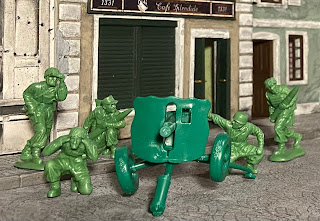
Mars German Paratroops w 10.5 cm LG 42 Tropical Uniform
This is a nice and original addition to the existing German Para units produced by other manufacturers which so far have lacked any heavy weapons support. The set includes two guns, each with its respective crew. They are meant to be painted in the tropical uniform. I actually purchased two sets, and plan to paint one crew in the early war (Crete) colors and the other one in the cammo scheme. The recoilless gun is interesting. The wheels are meant to be off the ground when it's deployed, but the plastic is a bit hard to straighten so that it looks even. I may actually use these crews with 21C Pak 40s. As far as the figures go, the poses are all good, but I do feel that the sculpting detail could be sharper.
Mars German Paratroops Mortar Team Tropical Uniform
Here's another useful addition to the German Para units. Again, the set comes with two mortars and two crews. When it comes to toy soldiers, I don't feel that you need a 5-man crew for a mortar. I know that in real life you might require such man power to carry the ammo plus the different pieces when it is disassembled, but I would have preferred to get maybe 3 mortars each with a 3-man crew or simply some other additional supporting poses with other unique weapons. In terms of the detail, these guys seem crisper than the gun crew. One interesting pose that took me a bit of time to figure out its purpose is the man at the front of the mortar holding the bipod. Looks like he is trying stabilize it.
Mars US Infantry Winter Uniform
Another good set from Mars, addressing a topic that is not covered very often. You get a decent set of weapons represented, including a rifle grenade, a sitting sniper, a radio man, plus some of the other more usual infantry poses, including a left-handed man firing from the standing position. There are however two things that I really don't like about this set. The first one is the posing of the grenade thrower. There is something strange about his stance. Maybe he needs to bend the knees a bit more, or maybe the fact that the head is aligned with the standing leg, just makes it look unnatural. The other thing that's not right is the manufacturing of the fourth man from the left. The two halves of his face are horribly misaligned. This is not the first time this happens with Mars figures. I really wish they paid more attention to such details.
Mars British Commonwealth Troops
This release from Mars portrays British Commonwealth Troops, which I guess means that you could use them as any number of nationalities. I know many collectors would like to use them as Canadian. What's nice about them is that a couple of them are wearing a leather vest, which I gather is called a jerkin. Another nice touch is that among their poses they have a prone piat firing team. As far as I recall, only 21C had made a prone piat firing paratrooper, but it did not have a loader. The set is pretty good overall, with almost all figures in good action, fighting poses. My only disappointment is the figure on the left, which I find very poorly sculpted. Like several other Mars figures, his arms are tucked next to his body as if he were trying to hold something with his arm pits. He actually looks worse when you look at him directly from the front. I really wish by now Mars had figured out how to properly sculpt arms in more natural positions.
Mars US MG Teams
This set consists of two machine gun teams in firing position, and a few other supporting figures. As far as I can tell, the two prone guys are operating a Browning 30 cal. MG. The two other guys are firing a water-cooled version of the same MG. The running and standing men are carrying additional MGs, tripods, and ammo. The set comes with 12 figures in total. The other 4 men are repeats of the running/standing men. In general, an OK set. I would not say it is a must have, as there are already other MG teams around from other manufacturers. And the sculpting has the same style of tucked arms as other previous Mars sets. But if you care about having a complete collection, it is still worth getting one set of these guys.
Mars German Tank Hunters
This is a highly specialized set focused on infantry anti-tank tactics. It comes with a nice variety of weapons, including land mines, panzerschrecks (with and without shield), a panzerfaust, a panzerknacker (hollow charge), and even an improvised bundle of potato mashers. The one weapon that is missing is the anti-tank rifle (panzerb
üchse), probably because it fell out of favor by mid-war as armor thickness increased. But still it might have been a good thing to have one instead of three panzerschrecks. I actually don't know if these guys would have been deployed as an independent unit or if they are simply a set meant to represent the range of options used for this purpose. I think I will sprinkle them across my other German infantry units rather than have them all as one.

Mars Soviet Border Guards
Normally you don't think of the Soviet border guards as the most exciting topic, but this set makes it look quite intense, and other than the guy who is observing the action with his dog, all the other guys are engaged in the fighting. But I know the dog is a key element of the Soviet guards, so it had to be fit in somehow with its handler. My favorite poses are probably the guy who is running and the officer. The officer was a bit tricky to get to stand straight, but nothing that the good old hot/cold water treatment couldn't fix. The other figure that is interesting is the crawling guy wearing the cammo suit. That guy is going to play double duty with my unit of Soviet scouts. This set certainly exceeded my expectations!
Mars US Marines
It's nice to see Mars cover this service branch. Not that it had been neglected by previous manufacturers, but for the sake of Mars collectors having a more complete range, it is good to see this set hit the market. Overall it is a good set, with nice action poses, and a good variety of weapons, including a flamethrower and two heavy machine guns. The larger one is a Browning M1917, and the smaller one is a Browning M1919. Unfortunately, this set suffers more noticeably from what I've been referring to as the tucked arm issue. I know that it has to do with the challenges imposed by two-part molds, but it still makes this set have several figures with right arms that are in very unnatural positions. Other than that, the sculpting is pretty good, so if you look at the figures from the right angle, you can avoid seeing the tucked arms. But all in all a good set.
Mars British Paratroops
It's nice to see Mars produce its second set of British troops and that it is representing the Airborne guys as we don't have many of those, at least not released recently. In this set we get a good variety of weapons in use - sten guns, bren gun, mortar, side arm, rifles, some variation in the head gear - helmets with netting and cammo foliage, plain helmet, helmet with netting only, as well as a beret. The poses are fairly decent with all men in useful combat poses. The most interesting poses for me are the two guys in the mortar team who is operating in a prone position. The only thing I noticed on the second man from the left is that its sub mg strap is missing a segment and yet it retains its curvature. This defect is present on both figures that came in the box of 15 men. These guys will go well with the British Airfix paras. Less so with the Conte guys who are a bit taller.
Mars US Paratroops - Set 2
Here we have some reinforcements for Mars' prior set of US paras. A good set of fighting poses. Something interesting about this guys is that several of them have their first aid kit on the side of their helmets. I am used to seeing them on the front. In terms of the poses, the most interesting guy is the one who is lying on the ground shooting at something likely coming at him after he fell backwards. I know... I am imagining a whole scene here. Another interesting guy is the one with the flamethrower. I don't recall seeing any other paras equipped with one. I even wonder if it's possible to safely jump off a plane with one. Or maybe he just found it on the ground. The mortar team is also nice as is the guy firing the 30 cal mg off the hip. One thing that was not so great about this set is that the bottom of the bases is a bit warped and has extra bits of plastic that have to be cut off or sanded off to get them to stand straight and without wobbling. It's doable, but it can take an extra 30-60 mins to do so.

Mars German Winter Paratroops with 10.5 cm Gun
This is a really nice set to complement the Mars German winter paras. Each crew consists of 5 men and you actually get 2 crews per box. I bought two boxes, so I now have 4 guns/crews, so I will likely assign 2 to the paras and 2 to the regular winter infantry. Those who are into conversions could replace the helmets to make them fit better as regular infantry. The best part about this set are the figures. The gun itself is made of softer plastic which bends quite a bit and needs to be straightened so that the gun stands evenly. A minor criticism is that the shells look wider than the gun's barrel. Looking at some pictures of the real equipment online, I think the shells are the ones which are too large. But let's not get too picky and instead be glad that we have this unique set to give our winter units some well needed firepower!
Mars Volkssturm Set 2
This set gives us a good mix of adhoc fighters for the final battles of the Reich. There are some young folks, including a girl second from left, as well as some older and disabled guys like the one with the eye patch, fourth from the left. You also get a nice variation in terms of outfits and head gear, like the firefighter helmet with the crest worn by the man on the left end. And the weaponry is also quite diverse, like the old MG08 machine gun with the drum magazine held by the man in the middle. My favorite pose ironically is the officer which could actually be used in a regular infantry unit beyond the Volkssturm. As you can tell from the positioning of the arms, this set was still sculpted with traditional mold-making in mind, even if in the end it was produced via 3D printing due to production challenges associated with the traditional mold making process. As far as scale, these guys are closer in size to Big 1/32 so they will match the Plastic Platoon Volkssturm guys better than the Mars Volkssturm Set 1 which is true 1/32 scale. But when it comes to 3D printing, I prefer larger figures as that makes them sturdier, particularly the weapons.

Mars German MG Teams
These guys are operating two types of machine guns and are guided by an officer who is spotting for them. The MG with the larger tripod is a MG08 left over from WWI and the one operated by the prone man is a MG37(t). The MG37(t) was also known as ZB-53 when it was produced by Czechoslovakia before Germany took over. This is also one of Mars' first sets designed to be 3D printed, which means that the sculpting is free of the constraints imposed by traditional molds. The result is a truly beautiful set. It's also worth mentioning that the resin chosen to print the figures gives them a texture very similar to plastic. The MG37(t) is printed in a different resin which I fear may be a bit more brittle, but I don't intend to test it :-) In contrast with prior sets, when you buy these you only get one figure of each pose and the price point is a bit higher than before, but the quality of the figures in terms of the poses, the level of detail, and the material seems well worth it!

Mars German MG Teams - bird's eye view
Here's another shot that allows us to get a better view of the prone men and the MGs. One interesting detail is that the assistant on the MG08 appears to have a rare EMP Erma submachinegun slung across his back. You can also see that the prone man can get his hands nicely around the handle of the MG37(t). The operator of the MG08 however can't really grip his handle as his thumbs prevent the handle from sliding in. I am tempted to snap off the handles, slide them into his hands, and then slide the hands into the MG. If it were actual plastic it would be a more predictable procedure, but with resin, I wonder if it will break at the wrong places... Anyhow, a very minor issue within an otherwise exquisite set.
Mars German MG Team - MG08 close up
I had an interesting time assembling the MG08 gun. The base has several holes and the one in which the gun's pin is supposed to go in is actually quite tight, but the other ones are a much better fit. The problem is that in order for the latch in the back of the gun to catch the back of the plate where it is supposed to slide as it rotates you need to insert the gun's pin into the very first hole on the tripod. It took a bit of turning as I did not want to press down hard and risk breaking it. But after a few turns I managed to wiggle it into place. I should point out that I actually reached out to Sergey from Mars to confirm where to mount it and he was very quick and helpful with his response!
Mars Winter Mortar Team - Part I
Another beautiful set. It was also designed for 3D printing, which means that the arms are all in much more natural positions. It is also great that we get more troops in winter uniform, particularly a mortar crew. One thing that I am not sure about is whether the man dropping the shell into the tube is supposed to stand on the left or the right side. Both appear to work, but when he is standing on the left as in the picture above, the shell is not quite on top of the tube, but that's the most it can go forward while still holding the tripod with his lower hand.
Mars Winter Mortar Team - Part II
Here's another possible configuration. In this one, the man with the shell can drop it into the tube more easily, but I feel that his face and ears are less protected from the explosion, so it seems less realistic. Another interesting vignette about this picture is that I took advantage of having real snow to take this picture. However I did not consider the effect of the low temperature on resin (it was pretty cold!) and unfortunately when I picked up the mortar, one of the legs snapped. As you can see in the prior picture, I was able to glue it back into place without much trouble but it was a good reminder that resin is not as flexible as plastic, particularly at very low temperatures! BTW, the reason why I retook the picture was not just that I wanted to position the man dropping the shell differently, but also because the prone man is not very visible given the shadows in the second picture. I hope you can get a better idea of how he is stabilizing the mortar based on both pics.

Mars US Mortar Team
This is another really nice set. A mortar team which could probably be used in both the ETO and the Pacific. Again, it was sculpted with 3D printing in mind and it shows. All poses appear so much more natural. I also love the level of detail. Look at the face of the radio man for instance. It is just as expressive as the faces of Plastic Platoon. I may like it even better as it is not overly intense. The muscles on the shirtless man are also very well done and in general, the detail such as the creases on the uniforms are all very realistic. And then there is the 4.2 inch (107mm) mortar with all its components clearly sculpted, including the thread for the angle adjusting mechanism. All remarkable for 3D printing. These guys do set a new standard for 3D printed figures!
Mars gets bonus points for having tackled this often overlooked service branch. These Italian Paras, most likely from the Folgore division which fought in North Africa are very nicely done. They are some of the recent sets made via 3D printing and you can tell how the poses are a lot more natural. The chosen printing material has improved and is able to capture a lot of detail and getting less brittle. I ordered these guys in 'Big 1/32' scale (1/30) and they go quite well next to the Waterloo 1815 Folgore Paras. In terms of the figures themselves, one thing that caught my attention is the diversity of head gear represented. Some of them are wearing the standard Italian helmet, although a couple of them with the paratrooper cover, one of them has a field cap on, a couple of them are wearing the Folgore beret, one of them appears to have a German Para helmet, and one of them is wearing a standard Italian infantry helmet (at first my imagination -or was it the netting?- tricked me into thinking it was a US army helmet!). Their weaponry is also pretty diverse, including a few German issued items like the panzerfaust and the potato masher grenade. One thing to consider though is that the panzerfaust went into service during the second half of 1943, so that figure is better suited to represent the Folgore paras who continued to fight against the Allies in Italy, likely at Anzio, after the armistice of Sept. 1943. Also interesting is the kneeling guy who is carrying a backpack with a couple of spare barrels for the Breda Mod 30 light MG being fired by the prone guy.



